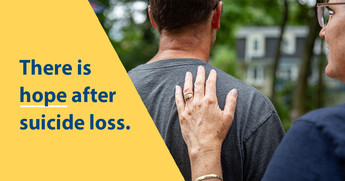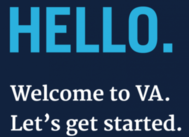|
|
|
SIGN UP | VIEW/SHARE | EVENTS | WELCOME KIT |
|
Today is International Survivors of Suicide
Loss Day. If a Veteran loved one has died by suicide, you are not
alone.
Browse nearly 500 questions and answers from the
Veterans Experience Live Survivors Together Q&A
Some survivors blame themselves for not noticing warning signs,
even though such signs may not have been obvious. And the effects extend
beyond close family members. Even first responders, who never personally knew
the deceased person, can be affected emotionally by the suicide scene. USPV provides postvention information and resources to assist
survivors as they navigate their healing journey, both immediately after the
loss and in the months and years that follow. What is postvention,
and who benefits from it?
Suicide prevention
aims to avert incident, while postvention
fosters healing afterward, for those touched by the loss. With tens of
thousands of suicides every year in the U.S., coping with the aftermath is an
unfortunate reality for more people than some might think. For every suicide,
an estimated average of 135 people are
affected. How is suicide postvention part of prevention?
Experts consider exposure to suicide a risk factor for suicide.
Survivors are at greater risk for substance use disorders and mental health
issues than those who haven’t experienced such a loss. This includes
including thoughts of suicide. Those exposed to suicide in the workplace are
3.5 times more likely than others to take their own lives. In a military unit
with five or more suicide attempts in a year, the risk for another attempt is
double that of units that had no attempts. Grief after loss can be so intense that it prevents survivors
from seeking help at a critical crossroad. But by helping survivors heal
after a suicide, postvention reduces the risk of additional suicides in the
deceased person’s circle. In that way, postvention healing is a vital
component of prevention. Postvention is so important that the Rocky Mountain
Mental Illness Research, Education and Clinical Center (MIRECC) has
established USPV as part of VA’s mission to develop, disseminate and
implement a comprehensive prevention program. To learn more about USPV at the Rocky Mountain MIRECC, visit https://www.mirecc.va.gov/visn19/postvention/. |
|
|
Resources If you know someone grieving after a suicide loss, you may wish
to read about ways
you can help and talk to them. To learn about mental health
support for Veterans, visit mentalhealth.va.gov.
|
|
|
|
Need
to contact VA?
Veterans Crisis Line: 1-800-273-8255 and press 1, Chat, or Text 838255 Don't
know what number to call?
1-800-MyVA411 (800-698-2411) is
never the wrong number |
|
Want
to receive this newsletter or other VA updates?
|
|
|
|
|
Disclaimer: The sharing of any non-VA information does not constitute
an endorsement of products or services on the part of the VA.
Sign Up to receive updates from Veterans
Affairs. Having questions or problems? Please visit subscriberhelp.govdelivery.com for assistance. If you are in crisis and need immediate help, please call
1-800-273-8255 and (PRESS 1) or visit http://www.veteranscrisisline.net/. Please remember the only secure way to ask personal questions is
at https://iris.custhelp.com. |
|
To be a Medicare Agent's source of information on topics affecting the agent and their business, and most importantly, their clientele, is the intention of this site. Sourced from various means rooted in the health insurance industry - insurance carriers, governmental agencies, and industry news agencies, this is aimed as a resource of varying viewpoints to spark critical thought and discussion. We welcome your contributions.
Monday, November 30, 2020
International Survivors of Suicide Loss Day
Zoom's Revenues Nearly Quintupled
|
|
By Nicholas
Jasinski | Monday, November 30 Pause.
The past three Mondays have begun with
promising Covid-19 vaccine news, which set the tone for the trading
day and much of the week that followed. Stocks of the most economically
sensitive and in-person sensitive businesses led the market, while social-distancing
beneficiaries lagged. The prospect of a light at the end of the tunnel
outweighed any concerns about the current record surge in coronavirus cases
and hospitalizations in the U.S. and abroad. The S&P
500, Nasdaq
Composite, and Russell
2000 all ended last week at record highs,
with the Dow Jones Industrial
Average at its third-highest close ever. Breaking the
Vaccine Mondays streak, today didn't feature much of a short-term catalyst,
and stock market trading dynamics were reversed. Virus-resistant technology
and health-care stocks rose, while cyclical energy and financials
were the biggest losers. The S&P
500 closed the month of November with a 0.5% loss, the Dow fell 0.9%, and the
small-cap Russell 2000 dropped 1.9%. The Nasdaq slipped less than 0.1%. In other
asset classes, however, the risk-off trade was absent: the 10-year Treasury
yield ticked higher, and gold prices fell while copper rose. If the
pattern continues, it suggests that the cyclicals-driven stock rally may
be due for a bit of a breather, but that investors' long-term base case of a
return to normal on the horizon is still intact. "The
disconnect likely has to do with the fact that just about everyone seems to
be talking about overbought conditions and extreme sentiment," Evercore's Dennis
DeBusschere wrote to clients today. "And cyclicals
have had a MASSIVE move relative to Defensive." The Dow
surged nearly 12% in November, its largest one-month percentage gain since
January 1987. The Russell 2000 finished the month up more than 18%, its
best month on record. Some pause in the rally shouldn't be a surprise. DeBusschere
expects this Friday's November jobs report to be relatively weak, given
significantly less seasonal holiday hiring by retailers and other firms
this year. Thursday's jobless claims data could likewise paint a picture of a
slowing recovery. After a big run-up, a couple of so-so data points can make
a larger dent than usual. Here's
DeBusschere on the puts and takes investors are currently considering: Negative
market scenarios tend to be some variation on the following theme. Sentiment
is extended and consumer confidence has stalled recently. Relatively weak job
growth over the next two months will constrain confidence putting stocks at
risk for a sharp pull back. Though that
story sounds plausible on its own, it largely ignores longer term trends and
assumes near term data will exert a heavy influence on asset prices. Vaccine
sentiment is improving and strong drug trial efficacy results suggest
economic normalization in mid-’21. Housing remains a source of significant
strength in the U.S., the savings rate remains elevated, and inventories are
low at a time when implied real yields are negative. Put it all
together, and the long-term picture still shows many good reasons for stocks
to be higher a year from now than they are today. But just don't expect
December to repeat November's gains. |
|
|
DJIA: -0.91% to 29,638.64 The Hot
Stock: Advanced Micro
Devices +6.3% Best Sector:
Technology +0.7% |




